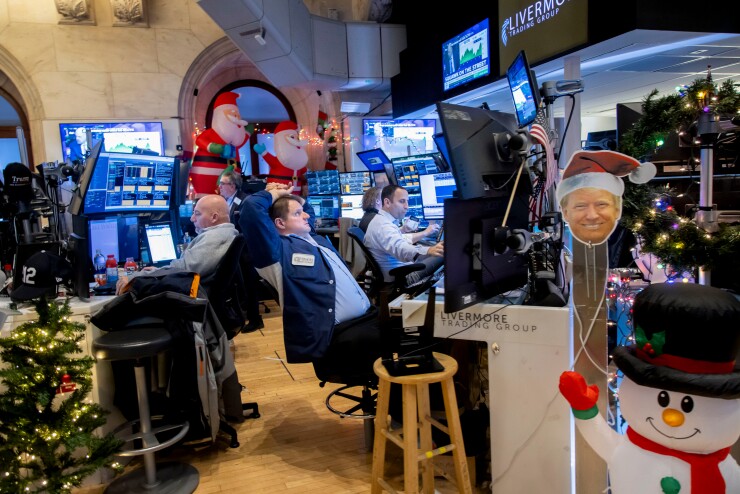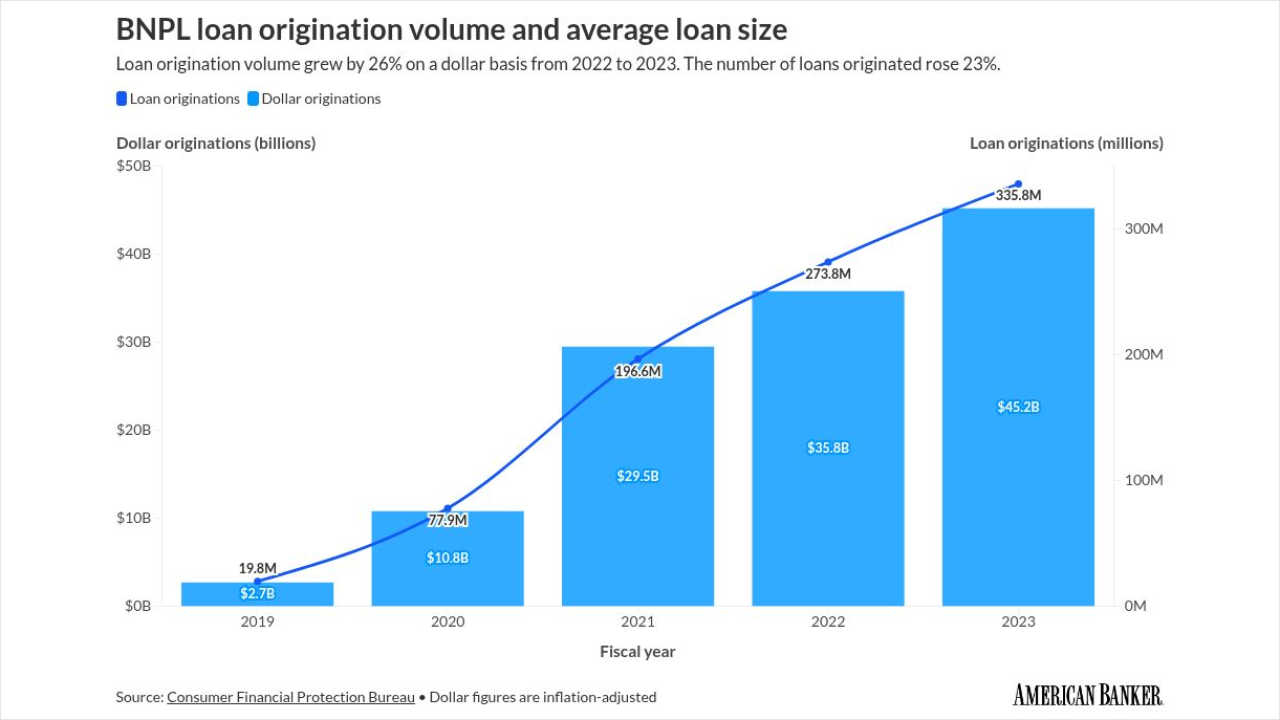
WASHINGTON — Bankers could benefit from a Trump-led deregulation push, but the incoming administration's policies might have a wider negative effect on the U.S. economy, which would also hurt banks, economists said.
Despite
Mark Zandi, chief economist at Moody's Analytics, said the primary metrics by which one assesses the health of the economy — joblessness, growth and asset valuations — all indicate that the U.S. economy is in exceptionally good health going into 2025.
"The economy Trump is inheriting is an exceptional one, at least in the aggregate," Zandi said. "The economy is growing strongly, creating lots of jobs. Unemployment is low and stable. The one blemish had been inflation, but that has come back to something we can all feel more comfortable with. The stock market's at a record high, housing values at a record high. So if you're among the third of Americans that own stocks, you're sitting in a very good place. If you're among the two-thirds of Americans that own their own home, you're feeling pretty good. So in the aggregate, the economy is exceptional — about as good as it gets."
Indeed, the economy does appear to be in good shape by the numbers. Unemployment is
"I think, generally speaking, we're going into 2025 with robust momentum," said Gregory Daco, chief economist of Ernst & Young's EY Parthenon. "So we have essentially three elements that I think are still supportive of growth: one, a robust labor market that is continuing to support income growth; two, procyclical productivity growth that is helping sustain strong supply conditions while alleviating some of the inflationary pressures; and three, an environment where there are still latent fiscal tailwinds. Those three factors have been essentially underpinning 3% growth in the U.S. economy."
Daco added that the baseline forecast for 2025 is already less rosy than the actual economic trend has been in 2024. That downward trajectory is attributable to a gradually cooling labor market impacting wage growth and consumer spending, he said. But that cooling economic projection for 2025 should be manageable.
"We're anticipating a bit of a slowdown of cooling and economic momentum in '25, with growth at 2% after 2.7% growth in '24," Daco said. "But it's not going to be anything alarming in the sense that that slowdown in momentum is just going to be a move back to trend, with … slower labor market momentum leading to cooler income growth and more cautious consumer spending [and] careful business investment because of the uncertainty on the policy front."
The Trump effect
Economists tend to think about economic projections in a linear fashion; there is a trend in unemployment, economic growth or inflation, and one can plot out how those trends are likely to behave barring some unforeseen external influence. The actual economy, of course, very much is influenced by external factors, foreseen or otherwise. And at the end of 2024, the biggest single foreseeable variable affecting the continued health of the U.S. economy is the policy agenda of President-elect Donald Trump.
Trump's presidential campaign promised, among other things, mass deportations of millions of undocumented migrants, tariffs against imports from the country's largest trading partners, a reduction in the federal regulatory burden, and extending and expanding the tax cut bill he signed in 2017 that is slated to expire next year. Some of those initiatives, like deregulation, could have a positive impact on overall economic growth if they free up corporate funds for research and development, investment or other growth-friendly priorities. But others, like deportations and tariffs, would create new inflationary pressures.
Without knowing the scale, depth and duration of those proposals, economists are unwilling to guess about how intense those impacts will ultimately be.

"We're going to get tariffs, but it's hard to know how broad-based and how high those tariffs will be," Zandi said. "We're going to get deportations of unauthorized immigrants, but it's hard to know what the scale of that deportation will be. We're going to get tax cuts — it's hard to know how big they are and whether they're going to be deficit-financed, and how much they're going to add to the deficit. You know, I think Trump will try to
Louise Sheiner, Robert S. Kerr senior fellow in economic studies and policy director for the Hutchins Center on Fiscal and Monetary Policy at the Brookings Institution, said even if economists had more detailed information about the president-elect's proposals, those proposals could have widely divergent secondary effects that are also difficult to quantify. In the case of deportations, she said, the standard economic principle is that removing someone from an economy has a direct and negative impact on that economy. But deportations could also drive current economic participants underground or otherwise dampen their activities, further reducing their contributions to the economy beyond the number of immigrants actually deported.
"Honestly, you can write all kinds of scenarios," Sheiner said. "So if you had massive deportations, that would be really disruptive in ways that we can't even imagine, because if it was really massive deportations, it wouldn't just [disrupt the economic activity of] the people you're deporting, but people who are scared to show up [to work]."
Federal Reserve Chair Jerome Powell
"There are many, many factors that go into how much tariffs will go into consumer inflation," Powell said. "We just don't know very much at all about the actual policies, so it's very premature to make any kind of conclusion," Powell said. "We don't know what will be tariffed, from what country, for how long, what size, we don't know whether there will be retaliatory tariffs. We don't know what the transmission of any of that will be to consumer prices."
Subsurface currents
The economic baseline also includes its own nonpolitical realignments that could factor into the economic picture for 2025. Sheiner said the ways that the working public has adjusted to life during and after the COVID-19 pandemic continue to reverberate in meaningful ways.
For one, the productivity gains that have underpinned economic growth over the last couple of years could be thanks in part to the pandemic. The trend of people
"If you go back to before the pandemic, productivity growth over that period is stronger than we would have guessed before the pandemic," Sheiner said. "And there are some possible reasons for that. There was a lot of switching jobs during the pandemic — people left their jobs, they went back and they found better jobs. It's quite possible that they got jobs that were more suited to their skills. Then the possibility of remote work means I could be taking a job someplace else."
The Biden administration's skepticism of big business and general caution coming out of the pandemic has also muted the M&A market over the last several years, leading to a pent-up desire for combinations. With the incoming Trump administration, however, the regulatory hurdles to bank mergers are likely to be reduced significantly, and when combined with pent-up demand, could
"I think the deal market is going to turn around," Daco said. "There's this general pro-business sentiment right now, and you're seeing investors wanting to deploy funds. And you're also likely to see that the anticipation of a lower interest rate, higher valuation environment could spark some exits as well. So you're likely to see this ideal combo of policy tailwinds and market tailwinds that combine for a better environment for the transactions market overall."
Daco added that the global economy is also becoming increasingly desynchronized. Until fairly recently, economies all over the world would go into boom-and-bust cycles at the same time, and central banks would respond to the cycles in tandem. But lately, monetary policy and economic fundamentals are diverging, and that trend is likely to continue into the future.
"I think one of the characteristics of the global growth outlook in '25 is going to be the high degree of desynchronization, because economies around the world are not at all evolving at the same pace," Daco said. "Inflation is not evolving in the same manner. Central banks are acting differently — that puts pressure on currencies, whether it's the euro, dollar or the renminbi or the yen."
Long and variable lags
But whatever those policies ultimately end up looking like, the impact on the economy in 2025 is likely to be muted.
"I do think 2026 will probably be a tougher year, because that's when the fallout from the policies will be reflected most fully in the data," Zandi said. "So it's really an end-of-year 2025, beginning of 2026 [time frame] when the impact from these policies will be felt the most."
Trump's proposals, for one, are not all going to take effect at the same time. Daco said that the deregulatory push and tax legislation in particular offer some bright spots for banks to look forward to in 2025.
"[The] push toward deregulation in the first half of the year, that's likely to affect the energy, space, banking sector, perhaps health care and likely the deal market," Daco said. "So you're likely to see those segments be more affected by deregulation and benefit from that tailwind."
Contrast that with more inflationary pressures like tariffs and immigration, which, depending on their magnitude, would pose more severe challenges to the economy. The effects of those policies will likely take some time to materialize, and the powers Trump uses to impose tariffs or deport migrants will dictate how long that lag ultimately is. Retaliatory tariffs might also result in lost American jobs and lower growth.
"I think the further we move into '26, the more you're going to see that desynchronization, because the greater the impact of tariffs is going to be on economies around the world," Daco said. "Now, if the president uses the … International Economic Emergency Powers Act, he would have the ability to do so much faster, and you could see tariffs being implemented in the first couple of months. If he uses the … now-traditional route, that's about 10 months to a year between the announcement and the implementation. So that's really a '26 story, and that's where you could see this stagflationary environment with lower growth, higher inflation."
But Zandi said the fundamentals in the U.S. economy are still strong, especially compared to other industrialized countries, and should be able to weather whatever the next year has in store.
"I think the American economy is a pretty tough thing to screw up," Zandi said. "We might take a crack at it, but I think it should be able to handle whatever is thrown at it in 2025."





